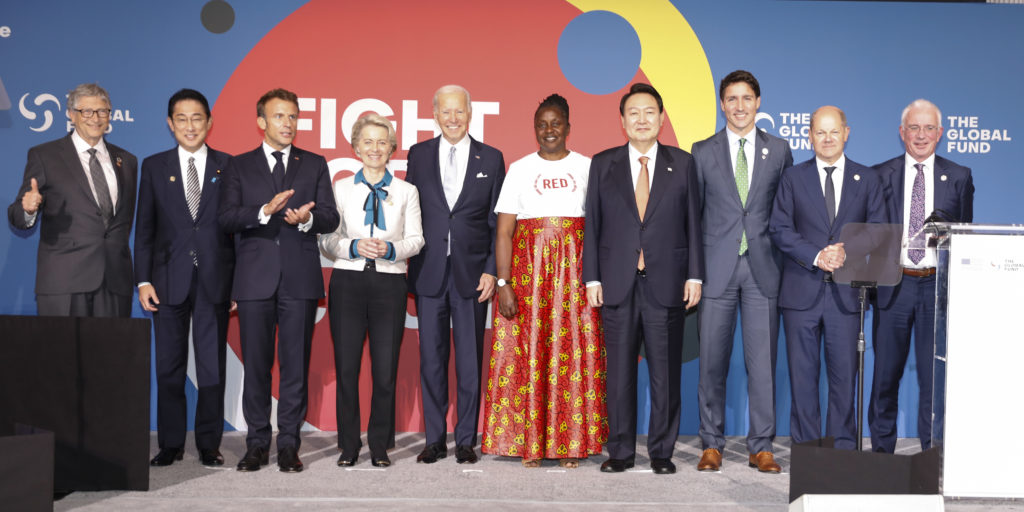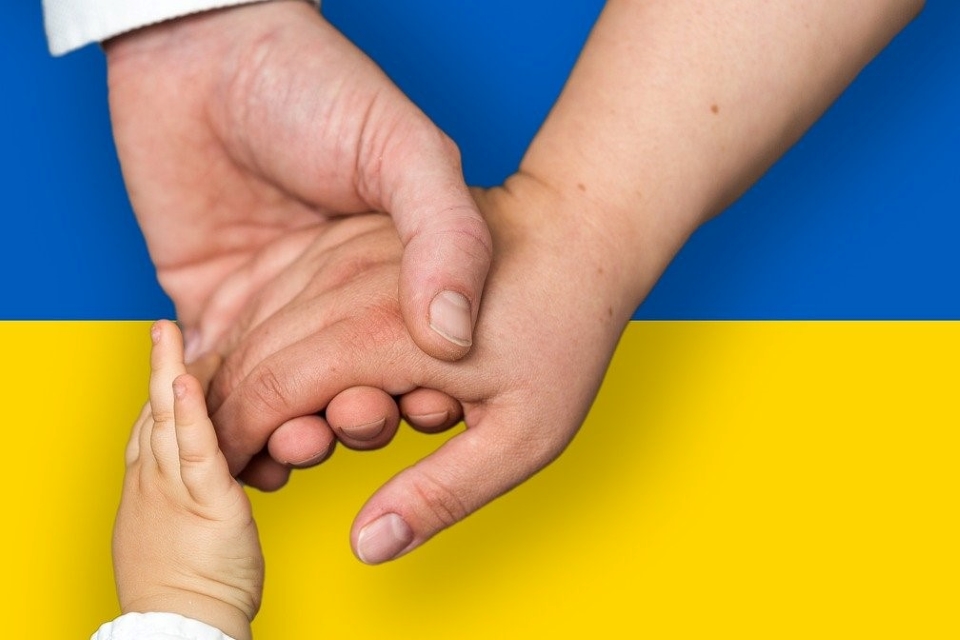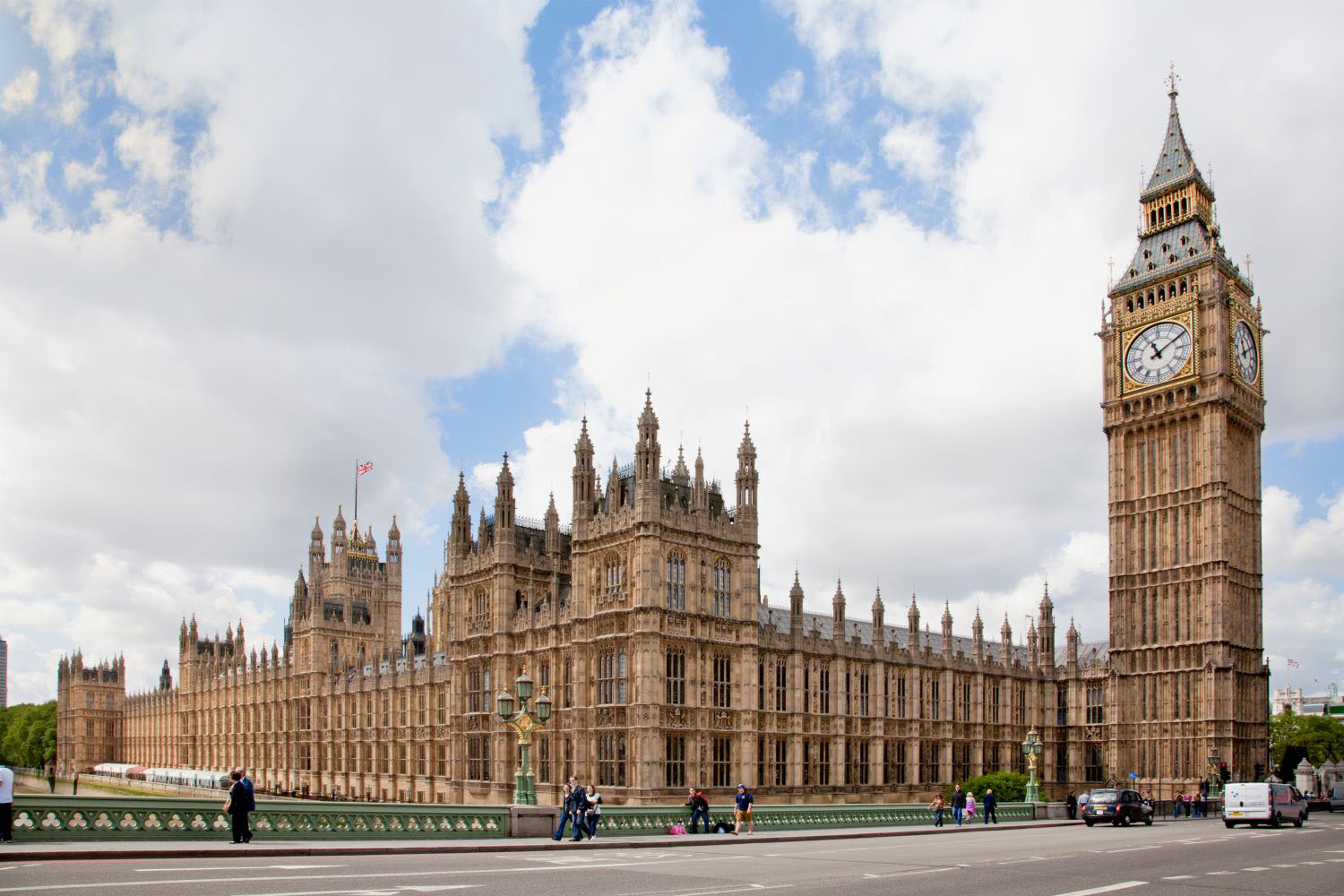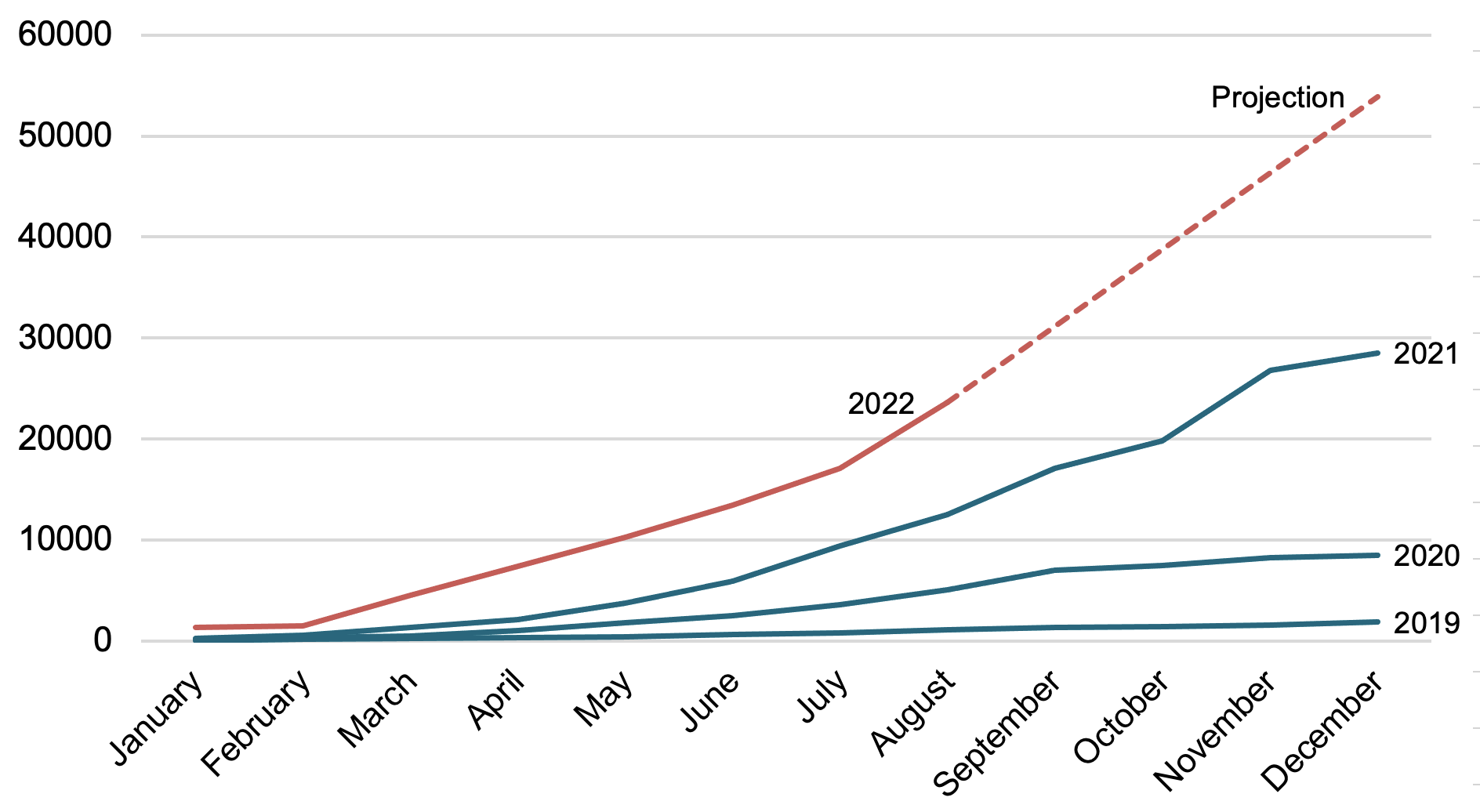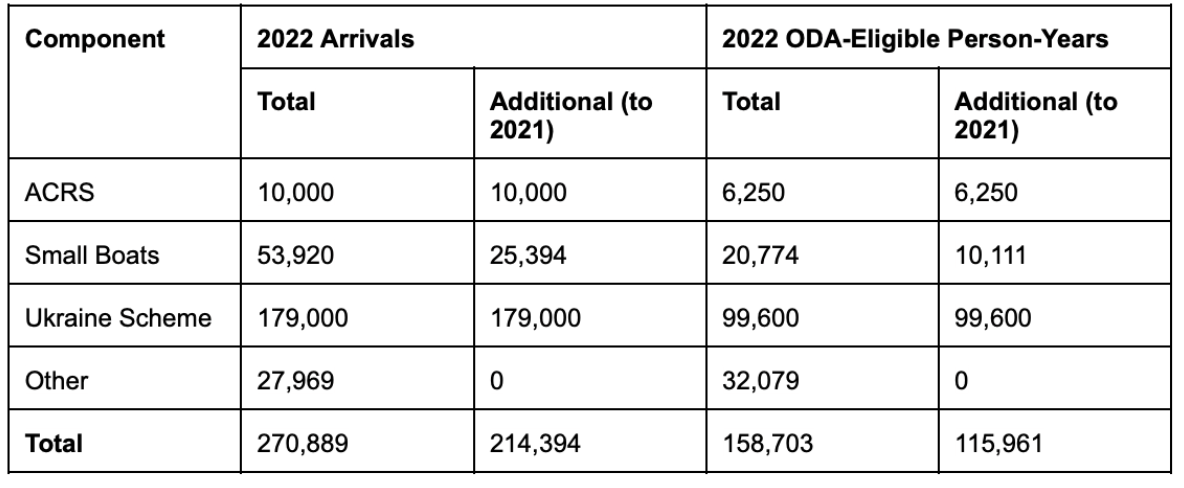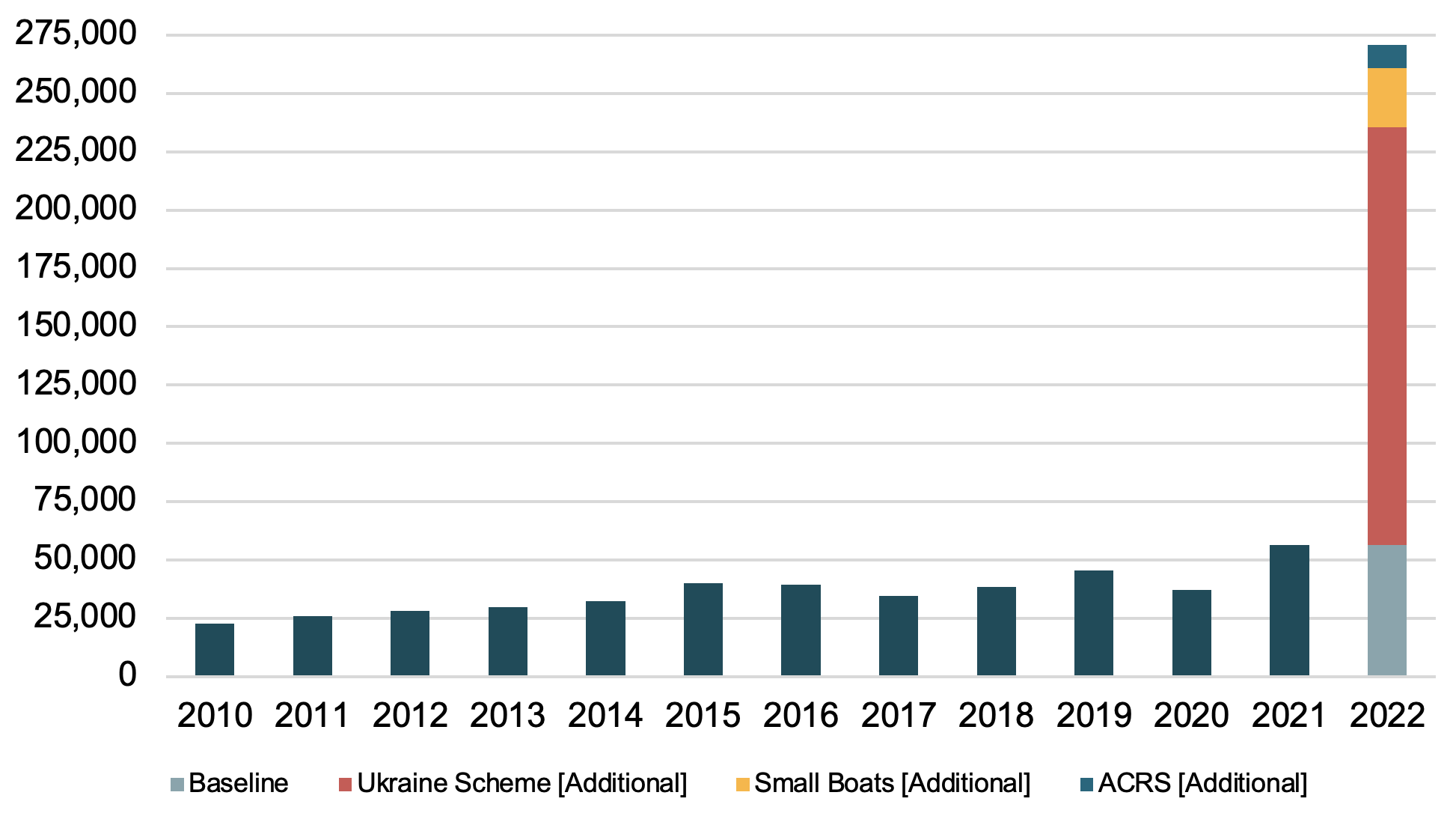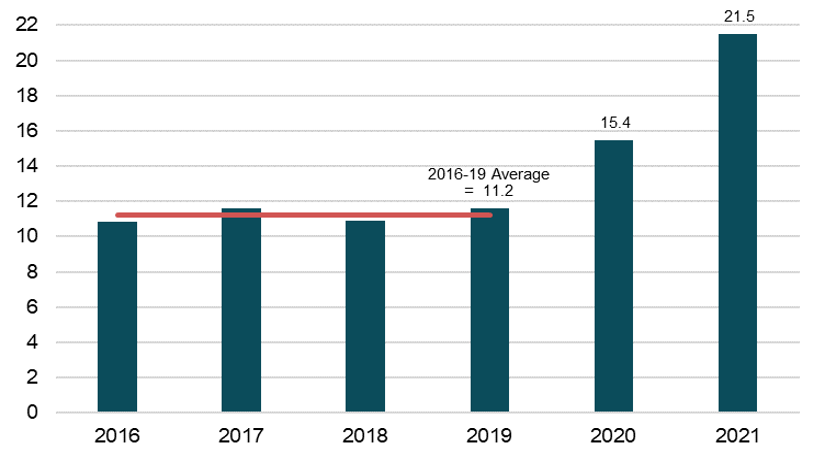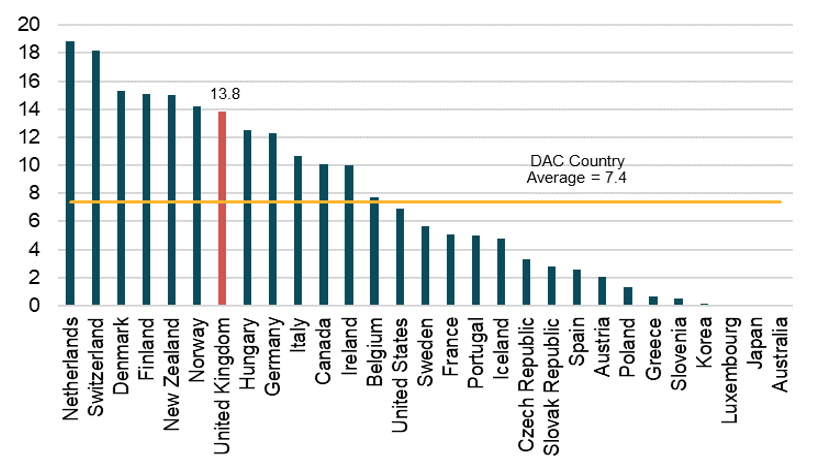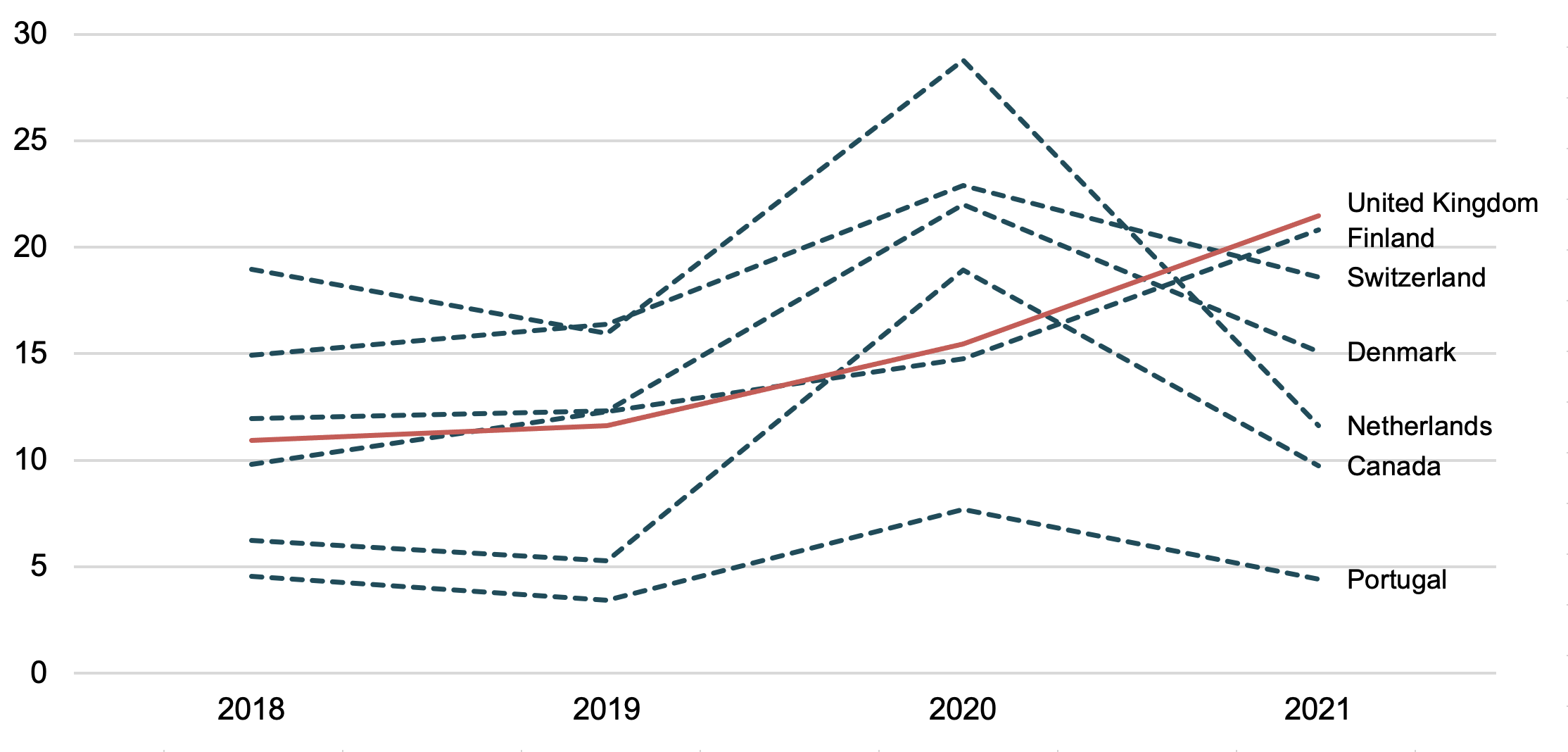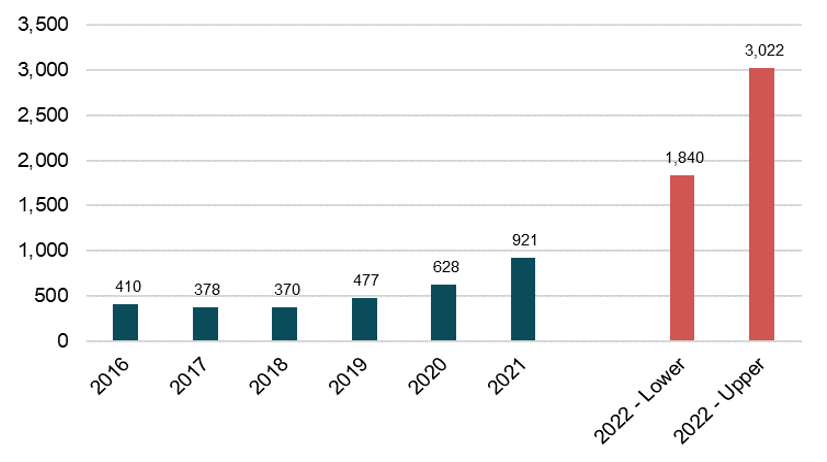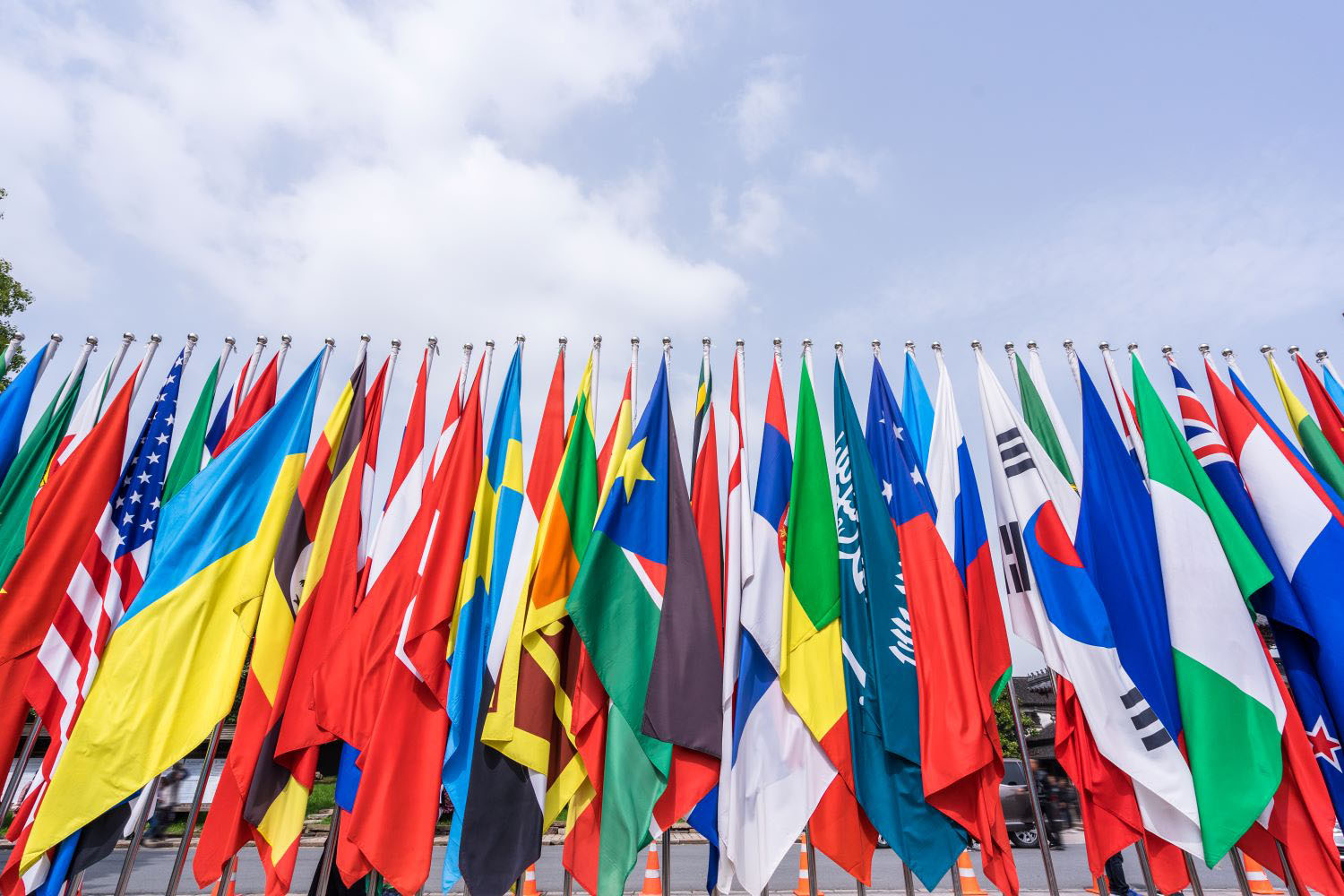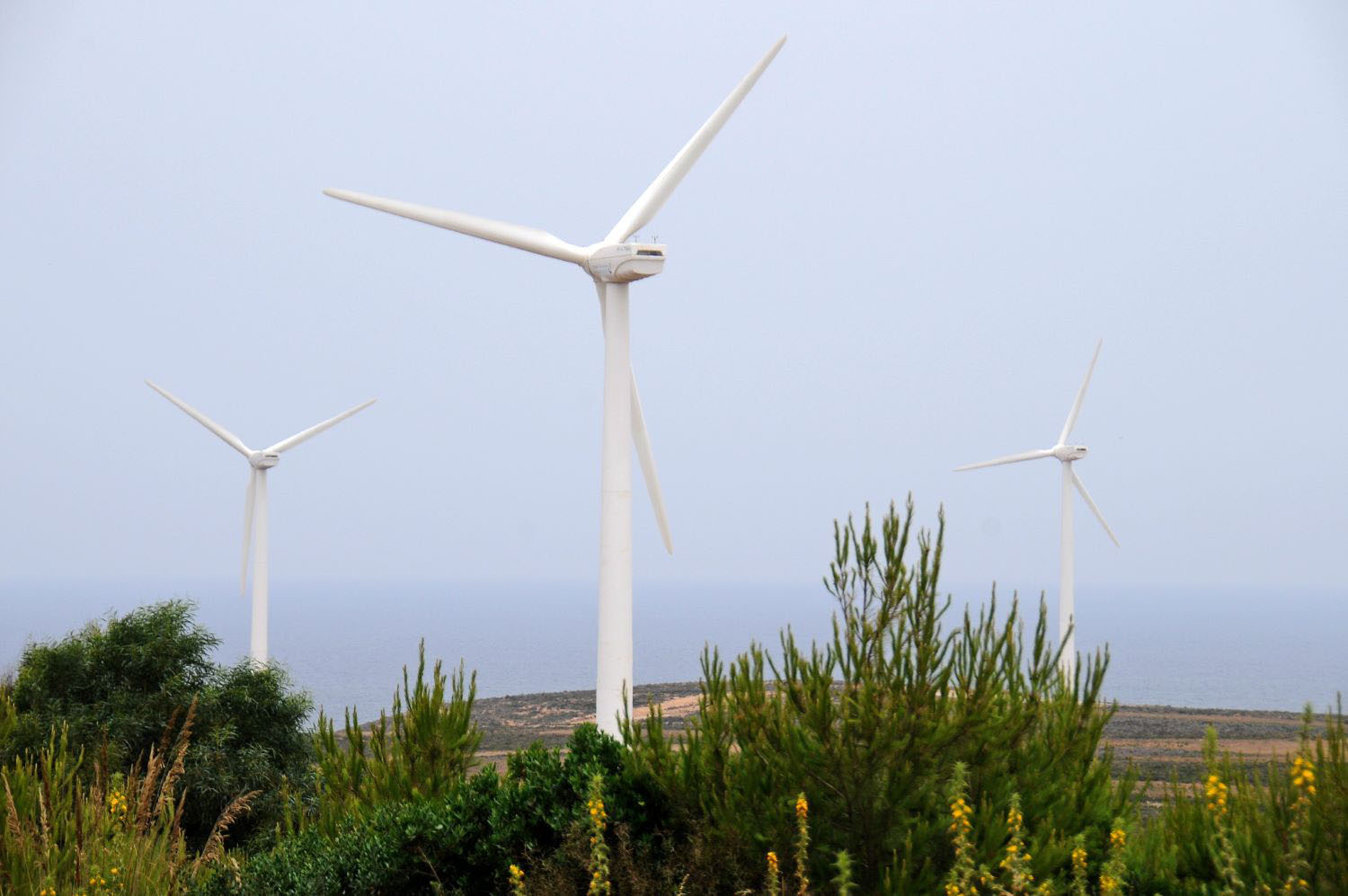Recommended
The UK is welcoming the highest number of refugees in at least four decades, having already issued over 180,000 visas to Ukrainians. But as things currently stand, the UK’s generosity is being met by reducing other aid programmes. Indeed, it has now frozen any “nonessential” spending.
In this note, we look at the potential numbers and cost of refugee hosting in the UK in 2022, how this compares to the UK’s historic approach, and the knock-on impact for the UK’s aid budget.
We find five key things:
-
The UK is expecting to receive its highest number of arriving refugees and asylum seekers for at least 40 years. Our analysis suggests around 270,000 arrivals, compared to a recent average of just under 40,000 with the vast majority of the increase from Ukrainian refugees.
-
The UK has almost doubled how much in-donor refugee aid it reports per recipient compared to pre-pandemic levels; and out of all DAC countries, only Hungary claimed more aid per recipient than the UK in 2021.
-
While it’s technically allowed to count refugee hosting costs as official development assistance (ODA), few countries, and none of the G7; are funding all the costs of Ukrainian refugees from their existing aid budget. The UK is.
-
This could mean that up to £3 billion, a quarter of the UK’s annual aid budget, is spent on hosting refugees in 2022.
-
Even with freezes in existing spend, increases in the aid budget from higher national income and expected reductions in payments to the EU, cuts of £900 million for aid programmes, some 8 percent, will still need to be made in 2022 to finance this. This would be the third round of cuts to these programmes in three years; and will be a significant blow both to the 131 countries receiving UK support and to the UK’s reputation.
The UK is accepting the largest number of refugee arrivals in 40 years, and asking a fixed aid budget to fund them all is creating a disproportionate pressure.
When the then-prime minister said the UK’s offer to Ukrainian refugees should be “as generous as possible”, he surely could not have meant it would be the world’s poorest people that would be footing the bill.
We argue that the UK’s new prime minister should make clear the funding for refugees is separate from the UK’s aid budget; and ensure the UK’s generosity in hosting refugees is just that.
Part 1. A major inflow of refugees to the UK
UK refugee generosity in context
Despite initial difficulties in the application system, the UK had issued 179,000 Ukrainian visas by late August (23/08/2022). This is more than France, but only around a sixth of Germany’s intake. And countries neighbouring Ukraine are taking a much greater number: notably Poland, hosting some 1.26m (as of 02/08/2022), equivalent to 33 per 1,000 population. (Out of the 40 countries covered by the Commitment to Development Index in 2021, only Turkey hosted a greater number of refugees per capita).
The number of Ukrainian arrivals in the UK is large relative to the UK’s historic asylum and refugee numbers. The number of visas exceeds the total number of refugees being hosted prior to the invasion (~137,000); and it is also greater than the maximum number of asylum applications it has ever received in a single year (~103,000 in 2002).
At the same time, the UK is seeing an increase in asylum applications independent of the invasion of Ukraine. These have averaged almost 39,000 a year between 2016-20, but increased to over 56,000 in 2021, which can largely be explained by the spike in arrivals via small boat Channel crossings (increasing by over 20,000 between 2020 and 2021). One might expect the crisis following the summer withdrawal from Afghanistan to contribute significant numbers but asylum applicants from Afghanistan only increased by about 1,500 in 2021. A second likely driver is a rebound in arrivals following the COVID-19-driven fall. The other more systematic factor is the end of the Dublin III Regulation from January 2021 which means the UK can no longer return failed applicants to other EU countries, potentially increasing the incentive of channel crossings for asylum seekers; and which the UK has sought to counter with its plan to send asylum seekers to Rwanda.
The combined effect of Ukrainian refugees, increased asylum applications and small boat crossings is that the number of UK arrivals of asylum seekers and refugees in 2022 is already the highest since at least 1979.
How much of aid budgets are spent on refugees?
Under rules set by the OECD’s Development Assistance Committee (DAC), clarified in 2017, the first-year costs of hosting asylum seekers or refugees (such as accommodation, subsistence, health and education) can be recorded as aid (ODA). This has been controversial, for not all agree that in-donor refugee costs meet the primary objective of ODA: to promote the economic development and welfare of developing countries. Nevertheless, refugee costs amounted to 5 percent of DAC countries’ bilateral ODA in 2021; up from 3 percent a decade earlier alongside significant increases in asylum applicants, particularly in Europe, over the period.
The UK’s ODA allocated to in-donor refugee costs increased over a hundred-fold between 2009 and 2021: from £9m to £918m (at constant 2020 prices). This reflected the decision to report refugee hosting as ODA for the first time in 2013, as the ODA budget rose to 0.7 percent of gross national income (GNI), followed by a steady increase in asylum applicants over the period.
Part 2. Estimating UK refugee arrivals in 2022
Additional arrivals of refugees and asylum seekers in 2022
We consider three components of refugees and asylum seekers where additional arrivals to the UK are expected in 2022: arrivals under the Ukraine Scheme; small boat arrivals; and the Afghan Citizens Resettlement Scheme (ACRS). After estimating the likely number of arrivals, we consider the related costs.
The UK can expect for the holders of the 179,000 visas already issued under the Ukraine Scheme (by late August) to arrive in 2022 (122,900 have already done so). In essence, this flow is entirely additional: asylum applicants from Ukraine numbered just 96 in 2021.
The UK is also seeing a substantial increase in arrivals due to irregular migration via small boat Channel crossings. Figure 1 projects the total number for 2022 under the assumption that the proportional increase on 2021 to August is maintained over the year.
Figure 1. Cumulative irregular migration to the UK via small boat Channel crossings by year
Source: CGD analysis, using Home Office and MoD data.
Note: The projection for 2022 is based on the assumption that the proportional difference in cumulative arrivals between 2021 and 2022 as of August will be maintained by December.
As of August, arrivals via small boats are 89 percent higher than the level this time last year. If this difference holds to the end of the year, the UK can expect a total of 53,920 arrivals in 2022; an annual increase in arrivals of over 25,000 (earlier this year, the Union for Borders, Immigration and Customs forecasted 60,000 arrivals in 2022, an even greater increase of over 31,000).
The UK will also see additional Afghanistan refugees arriving in 2022. The ACRS, opened in January, is expecting to resettle an additional 10,000 people in 2022, exceeding its initial aim of 5,000 in the first year. (This comes on top of the pre-existing and ongoing Afghan Relocations and Assistance Policy scheme, and compares to a baseline level of 3,000 asylum applicants through other channels from Afghanistan in 2021).
Combined, these three components sum to over 214,000 expected additional arrivals in 2022 (Figure 2). And adding these 2022 additional arrivals to baseline levels from 2021—which were already at a decadal high (see Figure 3)—yields over 270,000 arrivals in total.
(Figure 2 also reports the equivalent number of person-years of government support which we estimate are ODA-eligible in 2022—on which, more below).
Figure 2. Estimated additional asylum seekers & refugees to the UK in 2022
Source: CGD analysis, using Home Office, MoD and BBC data. ACRS = Afghan Citizens Resettlement Scheme
Figure 3. Asylum applicants to the UK
Source: CGD analysis, using Home Office and MoD data.
Part 3. Assessing the costs and potential ODA implications
In this section we consider how many of the new arrivals would be eligible to see costs reported as aid; and using simplified assumptions on those costs, what the total cost could be. It also looks at the implications if the UK government continues to treat its aid budget as a fixed envelope of 0.5 percent of GNI.
Thus far we have highlighted the expected number of arrivals in 2022, but this is not equivalent to the number of person-years which the UK could finance using its 2022 ODA budget. Even if we assume that each additional arrival will be supported by the UK government for a year, this does not imply that the 2022 ODA budget will fund an additional 214,394 person-years of first-year costs for refugees and asylum seekers. Those that arrive in July, for instance, will only receive half a year of ODA-eligible support drawn from the 2022 budget. Therefore, using data on the within-year date of 2022 arrivals when available, and otherwise assuming that arrivals will be evenly distributed over time, we calculate that an additional 115,961 person-years of support for refugees and asylum seekers will be ODA-eligible in 2022.
For comparison, we estimate that UK ODA funded the equivalent of 42,742 person-years of support for asylum seekers and resettled refugees in 2021. Adding the 2022 increase to the 2021 total, we can expect over 158,000 person-years of support for asylum seekers and refugees will be ODA-eligible in 2022, up 271 percent in one year.
How much will the UK claim on ODA spend per recipient?
It is notable that the UK’s reported spend per recipient has risen dramatically in the last two years for ODA allocated to in-donor refugee costs (IDRC). Pre-pandemic, the UK allocated about £11.2 thousand per recipient (2016-19 average, at constant 2020 prices); but this has almost doubled to £21.5 thousand in 2021.
Figure 4. UK in-donor refugee ODA spend per recipient (constant 2020 GBP thousands)
Source: CGD analysis, using UK Statistics on International Development, OECD, Home Office and ONS data.
Note: Spend per recipient is calculated as the UK’s bilateral ODA allocated to in-donor refugee costs, divided by the number of ODA-eligible person-years of supported asylum seekers and resettled refugees. The denominator is estimated using Home Office data on the total number of asylum applicants to the UK, assumes each will receive at least a year of support, and adjusts for the within-year application date (for instance, if an application is made in Q4 of 2019, only three person-months of ODA-eligible support are attributed to 2019, and the remaining nine person-months are attributed to 2020).
In 2021 the UK reported an IDRC ODA per recipient figure that was substantially higher than its own or others’ recent average. The UK’s 2021 spend per recipient (£21,479) was greater than any other DAC country’s equivalent spend over the 2018-21 period: almost three-times higher than the DAC average (£7.4k), and 14 percent higher than the next highest spending country (the Netherlands, £18.8k). If we look just at 2021, only Hungary spent more per recipient than the UK (£25.1k).
Figure 5. DAC countries’ 2018-21 average in-donor refugee ODA spend per recipient (constant 2020 GBP thousands)
Source: CGD analysis, using OECD, UNHCR and IMF data.
Note: Spend per recipient is calculated by dividing annual ODA gross disbursements allocated to in-donor expenditure on refugees (constant 2020 USD, converted to 2020 GBP at the official exchange rate of 0.78 in 2020) by the number of asylum applicants. The 2018-21 average reflects the period post-clarifications on IDRC ODA reporting. Since UNHCR data on asylum applications is reported by year rather than quarter, these estimates are not adjusted for the within-year application date like Figure 6.
It is unclear to what extent the UK’s increase in IDRC ODA spend per recipient reflects greater COVID-related costs; and whether we should expect the ODA spend per recipient in 2022 to remain high, or fall back to its pre-pandemic level. The UK did increase its weekly cash allowance for asylum seekers in the pandemic, but this 8 percent nominal rise between 2019 to 2021 (from £37.75 to £40.85) hardly accounts for the real terms doubling of total spend per recipient. We do know that several other DAC countries also saw significant increases to their spend per recipient during the pandemic; but most of these (all except Finland) then fell again in 2021, whereas the UK’s increased still further.
Figure 6. In-donor refugee ODA spend per recipient for selected countries during COVID-19 (constant 2020 GBP)
Source: CGD analysis, using OECD, UNHCR, IMF, UK Statistics on International Development, Home Office and ONS data.
Note: Spend per recipient for the UK is taken from Figure 6 (i.e. adjusting for within-year application date); and for non-UK DAC countries the figure is calculated using the method for Figure 7 (i.e. not adjusting for within-year application date).
Looking at some specific UK schemes for which we have per capita cost estimates available, we see that though the 2021 estimate above of £21.5 thousand is high, it is also plausible. For instance, we know that the Syrian Vulnerable Persons Resettlement Programme spent £21,060 of ODA per recipient between FY2015-FY2020; and a 2015 breakdown of annual costs per refugee in Essex averaged £23,420 for adults with benefits, but only £10,720 for adults without benefits, and in-between the two figures for young children. Under the Ukraine Sponsorship Scheme Local Authorities will receive £10,500 per person, and sponsors receive ‘thank you' payments of up to £4,200 a year (£350/month). Cash support could also be added to this, which for asylum seekers amounts to £2,124 a year (£40.85/week) and, though refugees are entitled to greater support, they may also claim less since they can work.
In summary, it is not clear from the UK’s reporting how it has arrived at its reported IDRC ODA spend which equates to £21.5 thousand per recipient in 2021. But these figures suggest that the UK tax-payer is either seeing poor value for money relative to any other country hosting refugees; that the UK is providing substantially better support for arrivals; or that the UK is reporting more of its costs relative to its peers. These may be topics for the Independent Commission on Aid Impact or the OECD’s DAC Secretariat to explore further.
Impact on the 2022 UK ODA budget
The UK is the only G7 country to treat its aid budget as fixed. So, while other countries may report significant refugee-related ODA, this often adds to the total aid spent, rather than reducing non-refugee spending. In this section, we consider the impact of refugee ODA if the UK maintains its aid budget as fixed.
From the above, we can take either a high or a low assumed level of ODA spend per recipient, and combine these with our calculation of 158,703 person-years of ODA-eligible support for asylum seekers and refugees in 2022 (based on 270,889 total arrivals in 2022). This results in an estimated range for the UK’s total 2022 in-donor refugee costs which are ODA-eligible.
For our lower estimate, we take the pre-pandemic 2016-19 average of £11.2 thousand per recipient, and for our upper estimate we use the 2020-21 average of £18.5 thousand (at constant 2020 prices). Using these, in nominal terms, the UK’s in-donor refugee ODA in 2022 may increase to between £1.8bn and £3.0bn, up from £0.9bn in 2021.
Figure 7. UK bilateral ODA allocated to refugees in donor country (nominal GBP millions)
Source: CGD analysis, using data from the UK Statistics on International Development and Figures 2 & 4.
So we could expect for at least an additional £919m of the UK government’s spend to be ODA-eligible in 2022 as in-donor refugee costs, which poses a problem given that the government is limiting the ODA budget at 0.5 percent of GNI.
As of July, the Office for Budget Responsibility still expects 5.4 percent nominal GDP growth in 2022-23. If that is also reflected in 2022 GNI, then the 0.5 percent aid budget will rise by the same percentage, equivalent to an increase of some £650m. Alongside declining contributions to the EU budget, which are likely to fall around £525m in 2022, this means we could expect almost £1.2bn of headroom in the 2022 ODA budget.
This headroom is sufficient to cover the additional £919m of ODA-eligible spending in our lower estimate, where the UK allocates £11.2 thousand to each recipient (its pre-pandemic level). However, it falls far short of our upper estimate (which assumes the higher level of spend per recipient in 2020-21 is maintained at £18.5 thousand). £2.1 billion of additional spending is ODA-eligible under this scenario. If the UK does not allow its aid budget to exceed 0.5 percent of GNI, this means that even if the entire ~£1.2bn of headroom was dedicated to funding rising in-donor refugee costs, then over £900 million of cuts would still be required to other aid programmes.
This cut is equivalent to 8 percent of last year’s budget. And this is the average—as some budgets are fixed, cuts would be steeper in other programmes. The cut comes on top of rising costs in many development programmes so this nominal cut would be even larger in real terms. Following the UK’s fall in GNI in 2020; and its reduction in aid spending to 0.5 percent of GNI in 2021; this would be the third round of cuts in three years.
No other country treats its aid commitment as a ceiling. The UK is unique, at least among the G7, in asking the poor countries in the world to pay the UK costs of hosting Ukrainian refugees. This will not be lost on the UK’s aid recipients. A fixed aid budget is not adequate in the extraordinary circumstances created by the war in Ukraine, and the UK government should allow new refugee funding that qualifies as ODA to exceed the 0.5 percent target.
You can find here the full calculations underlying the note.
Rights & Permissions
You may use and disseminate CGD’s publications under these conditions.


